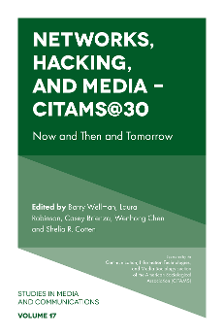
Index
Networks, Hacking, and Media – CITA MS@30: Now and Then and Tomorrow
ISBN: 978-1-78769-666-2, eISBN: 978-1-78769-665-5
ISSN: 2050-2060
Publication date: 27 November 2018
Citation
(2018), "Index", Wellman, B., Robinson, L., Brienza, C., Chen, W. and Cotten, S.R. (Ed.) Networks, Hacking, and Media – CITA MS@30: Now and Then and Tomorrow (Studies in Media and Communications, Vol. 17), Emerald Publishing Limited, Leeds, pp. 161-167. https://doi.org/10.1108/S2050-206020180000017009
Publisher
:Emerald Publishing Limited
Copyright © 2019 Emerald Publishing Limited
INDEX
Note: Page numbers followed by “n” with numbers indicate notes.
- Prelims
- Part I Field Analysis: Citams Past Chairs
- Chapter 1 CITAMS @30: Learning from the Past, Plotting a Course for the Future
- Chapter 2 Section Membership and Participation in the American Sociological Review Publication Process
- Chapter 3 How Information Technology Transforms the Methods of Sociological Research: Past and Future
- Part II Field Analysis: Relationships and Networks
- Chapter 4 In Sync, but Apart: Temporal Symmetry, Social Synchronicity, and Digital Connectedness
- Chapter 5 Romantic Dissolution and Facebook Life: A Typology of Coping Strategies for Breakups
- Chapter 6 Long Ties as Equalizers
- Chapter 7 Black-Hat Hackers’ Crisis Information Processing in the Darknet: A Case Study of Cyber Underground Market Shutdowns
- Chapter 8 I Click, Therefore I Am: Predicting Clicktivist-Like Actions on Candidates’ Facebook Posts During the 2016 US Primary Election
- Afterword
- Index